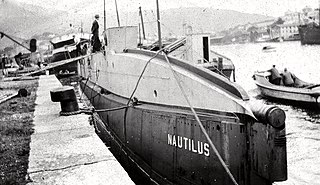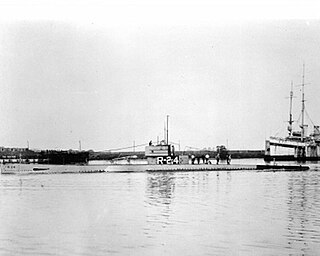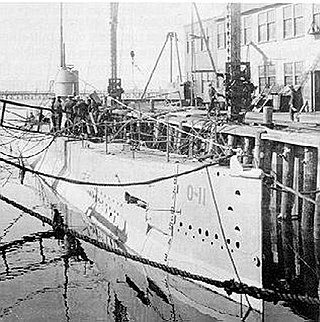
USS O-12 (SS-73) was an O-class submarine of the United States Navy. These later O-boats, O-11 through O-16, were designed by Lake Torpedo Boat to different specifications than the earlier Electric Boat designs. They performed poorly as compared to the Electric Boat units, and are sometimes considered a separate class. The ship was launched in 1917 and entered service with the Navy in 1918 in the Panama Canal Zone.

USS R-23 (SS-99) was an R-class coastal and harbor defense submarine built for the United States Navy during World War I.

USS R-23 (SS-100) was an R-class coastal and harbor defense submarine built for the United States Navy during World War I.

USS R-24 (SS-101) was an R-class coastal and harbor defense submarine built for the United States Navy during World War I.

USS R-26 (SS-103) was an R-class coastal and harbor defense submarine built for the United States Navy during World War I.

USS R-25 (SS-102) was an R-class coastal and harbor defense submarine built for the United States Navy during World War I.

USS R-27 (SS-104) was an R-class coastal and harbor defense submarine built for the United States Navy during World War I.

USS O-2 (SS-63) was one of 16 O-class submarines built for the United States Navy during World War I.

USS O-4 (SS-65) was one of 16 O-class submarines built for the United States Navy during World War I.

USS O-10 (SS-71) was an O-class submarine of the United States Navy. Her keel was laid down on 27 February 1917 by the Fore River Shipbuilding Company in Quincy, Massachusetts. She was launched on 21 February 1918 sponsored by Mrs. John E. Bailey, and commissioned on 17 August 1918.

USS O-11 (SS-72) was one of 16 O-class submarines built for the United States Navy during World War I.

USS N-5 (SS-57) was a N-class coastal defense submarine of the United States Navy. Her keel was laid down on 10 April 1915 by Lake Torpedo Boat Company in Bridgeport, Connecticut. The N-boats built by Lake had slightly different specifications from the ones built by Seattle Construction and Drydock and are sometimes considered a separate class.

USS L-5 (SS-44) was an L-class submarine built for the United States Navy during the 1910s.

USS G-2 (SS-27) was a G-class submarine of the United States Navy. While the four G-boats were nominally all of a class, they differed enough in significant details that they are sometimes considered to be four unique boats, each in a class by herself. G-2 was named Tuna when her keel was laid down on 20 October 1909 by the Lake Torpedo Boat Company in Bridgeport, Connecticut, making her the first ship of the United States Navy to be named for the tuna, a large, vigorous, spiny-finned fish highly esteemed for sport and food. She was renamed G-2 on 17 November 1911, launched on 10 January 1912 sponsored by Ms. Marjorie F. Miller, towed to the New York Navy Yard after the termination of the Lake contract on 7 November 1913 where she was completed, and commissioned on 1 December 1913.

USS G-3 (SS-31) was a G-class submarine of the United States Navy. While the four G-boats were nominally all of a class, they differed enough in significant details that they are sometimes considered to be four unique boats, each in a class by herself. G-3 was named Turbot when her keel was laid down on 30 March 1911 by the Lake Torpedo Boat Company in Bridgeport, Connecticut, making her the first ship of the United States Navy to be named for the turbot, a large, brown and white flatfish, valued as a food. She was renamed G-3 on 17 November 1911, transferred to the New York Navy Yard for completion on 17 November 1913 following the cancellation of the Lake contract, launched on 27 December 1913, and commissioned on 22 March 1915.

USS Alcedo (SP-166) was a yacht in the United States Navy. She was the first American vessel lost in World War I.

The United States Navy's sixteen O-class submarines were created out of the lessons learned from the L class. The O class were about 80 tons larger than the L class, with greater power and endurance for ocean patrols. Due to the American entry into World War I the O class were built much more rapidly than previous classes, and were all commissioned in 1918. O-1 through O-10 were group 1, designed by Electric Boat, O-11 through O-16 were group 2, designed by the Lake Torpedo Boat Company and sometimes considered a separate class. The group 2 boats entered service just before the end of World War I. Eight of the group 1 boats survived to serve in World War II as training boats when they were recommissioned in 1941.

USS Navajo III (SP-298), later USS SP-298, was an armed motorboat that served in the United States Navy as a patrol vessel from 1917 to 1919.

USS Mary Alice (SP-397) was a United States Navy patrol vessel commissioned in 1917 and sunk in 1918.

USS Helvetia (SP-3096) was a United States Navy patrol vessel in commission from 1918 to 1919.




















